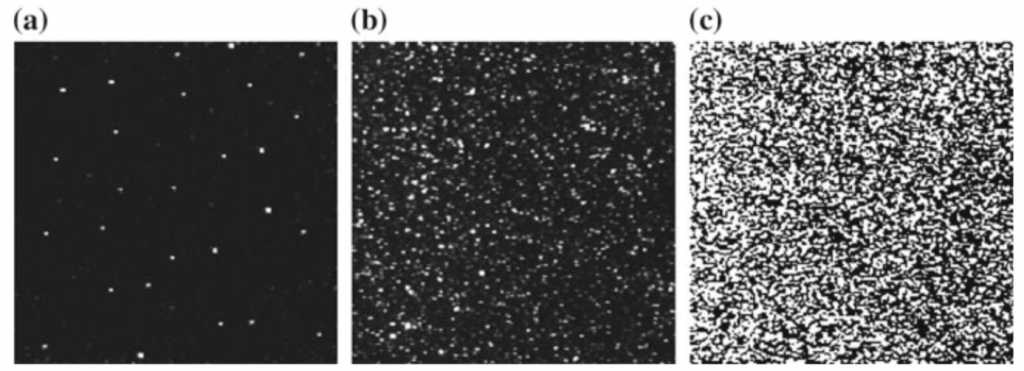(Particle Image Velocimetry (PIV
Particle Image Velocimetry (PIV) focuses on ensembles of tracing particles.
Density of tracing particles:
The density of tracing particles in the images are different in PIV, PTV, and LSV methods. In images with low density (figure (a)), individual particles could be detected with the tracking methods of evaluation which is performed in Particle Tracking Velocimetry (PTV) technique. In images with medium density (figure (b)), it is not possible possible to identify the same tracing particle in the images, so applying Particle Image velocimetry technique is required. In images with high density (figure (c)) since images overlap in most of the cases and form speckles, detecting individual images is not possible. So, these images need “Laser Speckle Velocimetry” (LSV) technique which is similar to other techniques.
Three types of particle density of images are:
- figure (a) with low density: PTV
- figure (b) with medium density: PIV
- figure (c) with high density: LSV


PIV experimental setup consists the following subsystems:
- Seeding: In most flows the seeding particles should be added to the system.
- Illumination: The seeding particles in the flow field should be illuminated.
- Recording: Camera should record the scattered light of seeding particles on separate frames.
- Calibration: To specify the exact displacement of seeding particles in the consecutive images the calibration is necessary.
- Evaluation: The recorded images should be evaluated to measure the displacement of seeding particles.
- Post-processing: Applying advanced post-processing is necessary to extract supplementary quantities or find and remove invalid velocity vectors.
Non-invasive, non-intrusive, and fast velocity measurement
In usual techniques of measuring the flow velocity such as pressure/Pitot tubes or hot wires, an intrusive probes which penetrate to the flow, affects the flow field. In contrast, PIV technique is an optical technique which is able to measure the whole velocity field non-invasively in a wide variety of applications of liquid and gaseous media. Non-invasivity, non-intrusivity, and fast responsibility of PIV technique allow the scientists to study the complicate and high speed phenomena such as shocks and boundary layers.

As PIV technique measures the velocity of seeding particles of flow field, selecting the proper seeding particles is very important. In fact the seeding particles should follow the streamlines to prevent discrepancy between motion of seeding particles and the fluid. Furthermore, the optical scattering behavior of seeding particles is a key factor in choosing of them.
